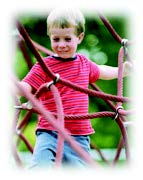 More and more children are overweight, to the point of obesity. According to a report from the Gatorade Sports Science Institute, there has been a dramatic increase in juvenile obesity over the last 15 years, not only in the U.S., Canada, and western Europe, but also in Latin America southeast Asia, and Africa, where children traditionally suffered from undernutrition.
More and more children are overweight, to the point of obesity. According to a report from the Gatorade Sports Science Institute, there has been a dramatic increase in juvenile obesity over the last 15 years, not only in the U.S., Canada, and western Europe, but also in Latin America southeast Asia, and Africa, where children traditionally suffered from undernutrition.
The culprit may well be a reduction in physical activity. The increase in indoor play, like watching television and playing computer games, is worldwide. Studies show that children who watch TV more than five hours a day are more likely to remain obese over a four-year period than those who watch one hour or less per day. But there’s more to the problem than that.
Why obese children are less active
It seems to be a vicious circle. Obese children may have a bad body image. This makes it harder for them to “get out there” and participate in sports or activities.
- They may feel ugly and are uncomfortable wearing “revealing” T-shirts, shorts, or swim suits in public – typical outdoor playtime clothes. This is particularly true for boys, who may see the fat pads in their chests as resembling female breasts.
- Often obese children are teased or ridiculed by others – most often at school, but also in the neighborhood and even at home.
- Obese children often have obese parents who also prefer an inactive lifestyle. A child’s activity in the first decade of life is strongly influenced by the way parents live.
- Because of their excessive weight, obese children often perform less well than their thinner peers in activities that including running or jumping – the basis of most team games and track and field events.
- Because of all these reasons, their low activity levels continue – and can cause the child to remain inactive and gain even more weight.
Benefits of activity
The ideal program for obese children and youth includes a change in diet, more physical activity, and a new attitude for both children and parents. If the activity level is increased and becomes a habit, the benefits are many. If the activity level drops again, these benefits disappear in a few weeks.
- Weight control
- Reduction in body fat
- Reduction in high blood pressure
- Decrease in the risk of adult-type diabetes
- Increased physical fitness and improved self-esteem
Upping that activity level
 Activities must be fun
Activities must be fun
Though adults are likely to do something because it is “good for them,” kids will react in the opposite way. Immediate gratification is the way to get kids to exercise. They need to see the activity as fun. So you need to identify the activities they like and plan to do more of them – avoiding those they find boring or too much work. These activities may change with time and the season.
Activities should get it moving
Ideally, activities should include moving the whole body over a good distance, so they burn energy. Though walking and jogging can do this, kids often see them as boring. Consider cycling, dancing, basketball, and skating. Include resistance training – It helps to add resistance training to the activities. It can increase lean mass, muscle strength, and self-esteem. The advantage of resistance training is that an increase of strength can be seen in just a few weeks
– that instant gratification we mentioned.
Build on their strong points
Obese children are usually tall and strong, so involve them in activities that use these strong points. Basketball and football are good examples. But because they are not as agile or fast, don’t expect them to be star players. They can also excel with throwing skills, like shot-put and discus. Track, soccer or jumping activities will probably not be right for them.
Water-based is great
Obese children often prefer water-based activities to land-based. Their fat layers help them to float and feel “lighter.” It also insulates them and prevents excess loss of body heat, giving them an advantage when the water is cool. And once they’re in the water, no one can see that body they’ve tried so hard to hide.
